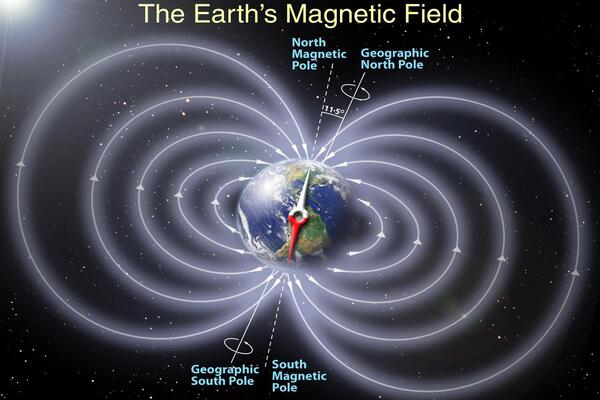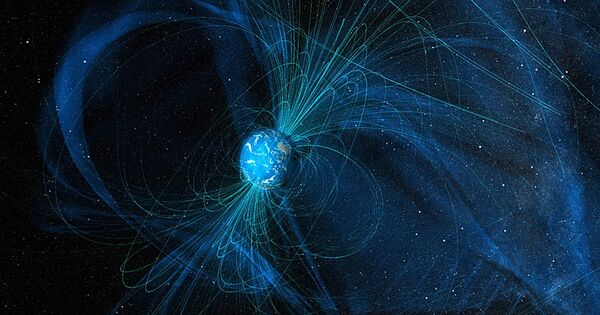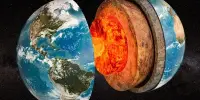A new study sponsored by the University of Oxford and MIT has recovered a 3.7-billion-year-old record of Earth’s magnetic field, which looks to be quite comparable to the field that surrounds Earth today. The findings were published today in the Journal of Geophysical Research.
Without its magnetic field, life on Earth would be impossible since it protects us from damaging cosmic radiation and charged particles released by the Sun (the ‘solar wind’). However, there is currently no accurate date for when the present magnetic field was originally developed.
In the latest study, researchers looked at an old series of iron-containing rocks from Isua, Greenland. When iron particles crystallize, they become tiny magnets capable of recording both magnetic field strength and direction. The researchers discovered that rocks dating from 3.7 billion years ago had a magnetic field strength of at least 15 microtesla, which is equal to the contemporary magnetic field (30 microtesla).
These findings provide the earliest estimate of the strength of the Earth’s magnetic field generated from complete rock samples, making the evaluation more precise and dependable than prior research that employed individual crystals.
Understanding how Earth’s magnetic field strength has varied over time is also key for determining when Earth’s inner, solid core began to form. This will help us to understand how rapidly heat is escaping from Earth’s deep interior, which is key for understanding processes such as plate tectonics.
Lead researcher Professor Claire Nichols (Department of Earth Sciences, University of Oxford) said: ‘Extracting reliable records from rocks this old is extremely challenging, and it was really exciting to see primary magnetic signals begin to emerge when we analyzed these samples in the lab. This is a really important step forward as we try and determine the role of the ancient magnetic field when life on Earth was first emerging.’
While the magnetic field appears to have remained largely consistent, the solar wind has historically been much stronger. This shows that the Earth’s surface has become more protected from the solar wind over time, allowing life to spread to the continents and leave the oceans’ protection.
The Earth’s magnetic field is formed by the mixing of molten iron in the fluid outer core, which is pushed by buoyancy forces as the inner core solidifies, resulting in a dynamo. The solid inner core had not yet formed during Earth’s early development, hence it is unclear how the early magnetic field was preserved. These new results suggest the mechanism driving Earth’s early dynamo was similarly efficient to the solidification process that generates Earth’s magnetic field today.

Understanding how Earth’s magnetic field strength has varied over time is also key for determining when Earth’s inner, solid core began to form. This will help us to understand how rapidly heat is escaping from Earth’s deep interior, which is key for understanding processes such as plate tectonics.
A significant challenge in reconstructing Earth’s magnetic field so far back in time is that any event that heats the rock can alter preserved signals. Rocks in the Earth’s crust often have long and complex geological histories that erase previous magnetic field information. However, the Isua Supracrustal Belt has a unique geology, sitting on top of a thick continental crust which protects it from extensive tectonic activity and deformation. This allowed the researchers to build a clear body of evidence supporting the existence of the magnetic field 3.7 billion years ago.
The findings may potentially shed new light on the function of our magnetic field in determining the evolution of the Earth’s atmosphere as we know it, particularly in terms of gas escape. The removal of the unreactive gas xenon from our atmosphere over 2.5 billion years ago remains an unsolved phenomena. Xenon is relatively heavy, therefore it is doubtful that it simply fell out of our atmosphere. Recently, scientists have begun to look into the idea that charged xenon particles were ejected from the atmosphere by the magnetic field.
In the future, researchers seek to learn more about Earth’s magnetic field before the development of oxygen in the atmosphere roughly 2.5 billion years ago by studying additional ancient rock sequences in Canada, Australia, and South Africa. A deeper understanding of the ancient strength and unpredictability of Earth’s magnetic field may help us decide if planetary magnetic fields are necessary for life to exist on a planet’s surface, as well as their function in atmospheric evolution.
















